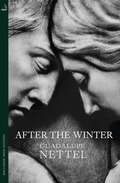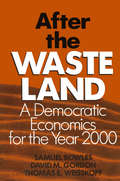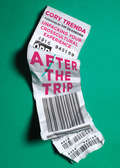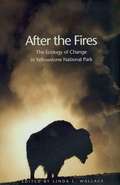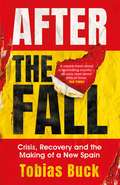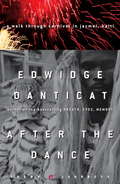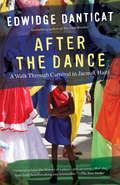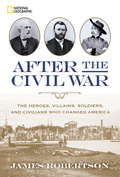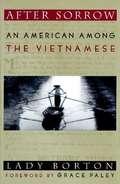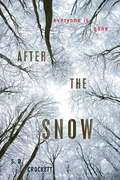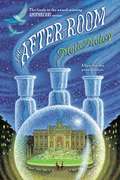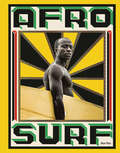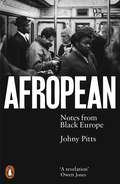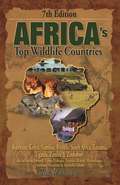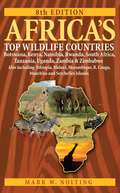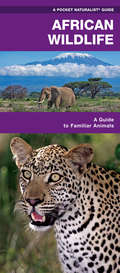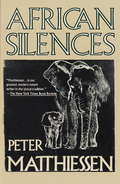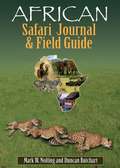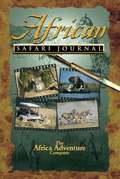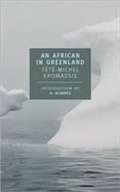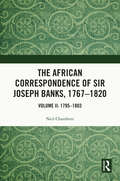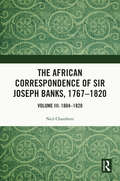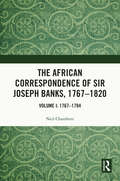- Table View
- List View
After the Winter (MacLehose Press Editions #10)
by Guadalupe Nettel"I envy how naturally she makes use of language; her resistance to ornamentation and artifice; and the almost stoic fortitude with which she dispenses her profound and penetrating knowledge of human nature. What's more, in this novel, she has impeccable syntactic control, and her ear is sharper than ever before" Valeria Luiselli, GuernicaA shy young Mexican woman moves to Paris to study literature. Cecilia has few friends, and a morbid fascination with watching the funerals taking place in Père-Lachaise cemetery outside her apartment. She suddenly strikes up a close relationship with her neighbour, a sickly young man who shares her interest in death and believes we can communicate with the dead. After coming to entirely depend on him for company and routine, Cecilia is left devastated by his decision to go to Sicily for his health, and is left alone in an unfriendly city once more.Claudio, meanwhile, lives in New York with the submissive, quiet, but very wealthy Ruth. She makes few demands of him, while acquiescing to all his desires and indulging his obsessive, misogynistic nature. He meets Cecilia by chance when visiting a friend in Paris and their two very different worlds collide with transformative consequences.With startling intensity, humour and insight, Nettel conjures a dark fable about obsession, denial and our modern ability to reach out across the globe in search of love.Translated from the Spanish by Rosalind Harvey
After the Waste Land: Democratic Economics for the Year 2000
by Samuel Bowles David M. Gordon Thomas E. WeisskopfThis critique of Reaganomics attempts to provide alternatives to both the supply experiments of the 1980s and neoliberal strategies of austerity. It presents arguments for economic democracy with a worker-oriented blueprint for improving productivity, growth, employment and economic justice.
After the Trip: Unpacking Your Crosscultural Experience
by Cory Trenda Tim DearbornVeteran trip leader and intercultural guide Cory Trenda says yes—if we let the trip launch a journey of integrating the experience into our ongoing life. In After the Trip Trenda provides a unique guide for individuals and teams to make the most of a crosscultural trip after returning home. Readers will find help with navigating the crucial reentry process, remembering and sharing key stories, interweaving new insights into everyday life, and engaging in continuing learning and service. Combining practical tips, reflections, and stories from Trenda's own decades of crosscultural travel, this is an essential resource for organizations, churches, schools, and all travelers who want crosscultural trips to be a catalyst for lasting good. The trip itself is just the beginning; real life change happens after the trip.
After the Fires: The Ecology of Change in Yellowstone National Park
by Linda L. WallacePlant and fire ecologist Wallace (U. of Oklahoma) provides a comprehensive scientific summary of the effects of the dramatic fires that tore across Wyoming and Montana in 1988. Even before the ashes had cooled, scientists from many disciplines began research, asking critical questions about the extent and intensity of the fires and initiating studies to determine the effects on geology, hydrology, plant and animal ecology, aquatic ecosystems, and landscape and ecosystem structure and function. The collection shows that the largest effects were found to have been felt at the smallest scales, and that the long-term devastation that had been predicted did not come to pass. Annotation ©2004 Book News, Inc. , Portland, OR (booknews. com)
After the Fall: Crisis, Recovery and the Making of a New Spain
by Tobias BuckTobias Buck arrived in Madrid in December 2012, in time to celebrate the bleakest Christmas the city had seen in a generation. Capital and country were reeling from a series of economic shocks that had brought Spain to the brink of ruin. The housing boom had dramatically turned to bust, a large chunk of the nation's banking system was in state hands, businesses were closing across the country, debt was spiralling out of control and unemployment levels had reached a record high.AFTER THE FALL presents a rich and vivid portrait of contemporary Spain at a critical moment in the country's history. The book tells the story of Spain's long boom and sudden bust, the brutal economic crisis that followed, and the political and social aftershocks that reverberate to this day. It explores the origins of the separatist movement in Catalonia, and its bitter clash with the Spanish government that culminated in a failed secession referendum and a divisive declaration of independence. It looks at the legacy of the Civil War and Franco dictatorship, and the continuing struggle over historical memory in Spain today. Based on five years of reporting and hundreds of interviews, AFTER THE FALL takes the reader from the offices of power in Madrid and Barcelona to the villages of the Basque country, still haunted by the memory of political violence, and to the towns of Andalusia, where an entire generation has seen its economic hopes shattered. It describes how the country has been changed by the experience of migration, and why - after decades at the margins - the far-right eventually made a return to Spanish politics. For all the problems and challenges facing Spain today, we see that amid the ruins of the crisis, the search for a new Spanish model is already underway.
After the Fall: Crisis, Recovery and the Making of a New Spain
by Tobias BuckTobias Buck arrived in Madrid in December 2012, in time to celebrate the bleakest Christmas the city had seen in a generation. Capital and country were reeling from a series of economic shocks that had brought Spain to the brink of ruin. The housing boom had dramatically turned to bust, a large chunk of the nation's banking system was in state hands, businesses were closing across the country, debt was spiralling out of control and unemployment levels had reached a record high.AFTER THE FALL presents a rich and vivid portrait of contemporary Spain at a critical moment in the country's history. The book tells the story of Spain's long boom and sudden bust, the brutal economic crisis that followed, and the political and social aftershocks that reverberate to this day. It explores the origins of the separatist movement in Catalonia, and its bitter clash with the Spanish government that culminated in a failed secession referendum and a divisive declaration of independence. It looks at the legacy of the Civil War and Franco dictatorship, and the continuing struggle over historical memory in Spain today. Based on five years of reporting and hundreds of interviews, AFTER THE FALL takes the reader from the offices of power in Madrid and Barcelona to the villages of the Basque country, still haunted by the memory of political violence, and to the towns of Andalusia, where an entire generation has seen its economic hopes shattered. It describes how the country has been changed by the experience of migration, and why - after decades at the margins - the far-right eventually made a return to Spanish politics. For all the problems and challenges facing Spain today, we see that amid the ruins of the crisis, the search for a new Spanish model is already underway.
After the Dance
by Edwidge DanticatInAfter the Dance, one of Haiti’s most renowned daughters returns to her homeland, taking readers on a stunning, exquisitely rendered journey beyond the hedonistic surface of Carnival and into its deep heart. Edwidge Danticat had long been scared off from Carnival by a loved one, who spun tales of people dislocating hips from gyrating with too much abandon, losing their voices from singing too loudly, going deaf from the clamor of immense speakers, and being punched, stabbed, pummeled, or fondled by other lustful revelers. Now an adult, she resolves to return and exorcise her Carnival demons. She spends the week before Carnival in the area around Jacmel, exploring the rolling hills and lush forests and meeting the people who live and die in them. During her journeys she traces the heroic and tragic history of the island, from French colonists and Haitian revolutionaries to American invaders and home-grown dictators. Danticat also introduces us to many of the performers, artists, and organizers who re-create the myths and legends that bring the Carnival festivities to life. When Carnival arrives, we watch as she goes from observer to participant and finally loses herself in the overwhelming embrace of the crowd. Part travelogue, part memoir, this is a lyrical narrative of a writer rediscovering her country along with a part of herself. It’s also a wonderful introduction to Haiti’s southern coast and to the true beauty of Carnival.
After the Dance: A Walk Through Carnival in Jacmel, Haiti (Updated) (Vintage Departures)
by Edwidge DanticatIn After the Dance, one of Haiti's most renowned daughters returns to her homeland, taking readers on a stunning, exquisitely rendered journey beyond the hedonistic surface of Carnival and into its deep heart.Edwidge Danticat had long been scared off from Carnival by a loved one, who spun tales of people dislocating hips from gyrating with too much abandon, losing their voices from singing too loudly, going deaf from the clamor of immense speakers, and being punched, stabbed, pummeled, or fondled by other lustful revelers. Now an adult, she resolves to return and exorcise her Carnival demons. She spends the week before Carnival in the area around Jacmel, exploring the rolling hills and lush forests and meeting the people who live and die in them. During her journeys she traces the heroic and tragic history of the island, from French colonists and Haitian revolutionaries to American invaders and home-grown dictators. Danticat also introduces us to many of the performers, artists, and organizers who re-create the myths and legends that bring the Carnival festivities to life. When Carnival arrives, we watch as she goes from observer to participant and finally loses herself in the overwhelming embrace of the crowd.Part travelogue, part memoir, this is a lyrical narrative of a writer rediscovering her country along with a part of herself. It's also a wonderful introduction to Haiti's southern coast and to the true beauty of Carnival.
After the Civil War
by James RobertsonReturning to the turbulent days of a nation divided, best-selling author and acclaimed historian James Robertson explores 70 fascinating figures who shaped America during Reconstruction and beyond. Relentless politicians, intrepid fighters, cunning innovators--the times called for bold moves, and this resilient generation would not disappoint. From William Tecumseh Sherman, a fierce leader who would revolutionize modern warfare, to Thomas Nast, whose undefeatable weapon was his stirring cartoons, these are the people who weathered the turmoil to see a nation reborn. Following these extraordinary legends from the battle lines to the White House, from budding metropolises to the wooly west, we re-discover the foundation of this great country.From the Hardcover edition. of post-assassination Washington and avenge the Union with harsh punishments for Confederate president Jefferson Davis. Together their stories tell the complex and fast-paced history of America as the country struggled to reunite and adapt to the inevitable changes wrought by war. The Greatest Generation of their day, the 75 figures in this book would forever change--and be changed by--the Civil War.From the Hardcover edition.
After Sorrow: An American Among the Vietnamese
by Lady BortonMoving story of the people of Viet Nam by an American woman whose experiences in Viet Nam span 25 years. Tells stories of ordinary people, especially women, during and since the war.
After The Snow (After The Snow #1)
by S. D. CrockettThe oceans stopped working before Willo was born, so the world of ice and snow is all he's ever known. He lives with his family deep in the wilderness, far from the government's controlling grasp. Willo's survival skills are put to the test when he arrives home one day to find his family gone. It could be the government; it could be scavengers--all Willo knows is he has to find refuge and his family. It is a journey that will take him into the city he's always avoided, with a girl who needs his help more than he knows.
The After-Room
by Maile Meloy Ian SchoenherrIt's 1955, and Benjamin Burrows and Janie Scott are trying to live a safe, normal life in America. It's not easy, when they have the power to prevent nuclear disaster, and sinister forces are circling. Soon the advice of a mysterious, unscrupulous magician propels Janie and Benjamin into danger, and toward the land of the dead. Meanwhile, their friend Jin Lo washes up on a remote island where an American spy is stationed, and finds herself on the trail of a deadly threat in China. But she's on the other side of the world--how can Janie and Benjamin reach her? The triumphant finale in the trilogy that began with Maile Meloy's bestselling, critically acclaimed The Apothecary, and continued in its captivating sequel, The Apprentices, The After-Room is full of enchantment and heart, with Ian Schoenherr's stunning illustrations throughout.From the Hardcover edition.
AFROSURF
by Mami WataDiscover the untold story of African surf culture in this glorious and colorful collection of profiles, essays, photographs, and illustrations. AFROSURF is the first book to capture and celebrate the surfing culture of Africa. This unprecedented collection is compiled by Mami Wata, a Cape Town surf company that fiercely believes in the power of African surf. Mami Wata brings together its co-founder Selema Masekela and some of Africa's finest photographers, thinkers, writers, and surfers to explore the unique culture of eighteen coastal countries, from Morocco to Somalia, Mozambique, South Africa, and beyond. Packed with over fifty essays, AFROSURF features surfer and skater profiles, thought pieces, poems, photos, illustrations, ephemera, recipes, and a mini comic, all wrapped in an astounding design that captures the diversity and character of Africa.A creative force of good in their continent, Mami Wata sources and manufactures all their wares in Africa and works with communities to strengthen local economies through surf tourism. With this mission in mind, Mami Wata is donating 100% of their proceeds to support two African surf therapy organizations, Waves for Change and Surfers Not Street Children.
Afropean: Notes from Black Europe
by Johny PittsWinner of the Jhalak Prize'A revelation' Owen Jones'Afropean seizes the blur of contradictions that have obscured Europe's relationship with blackness and paints it into something new, confident and lyrical' Afua Hirsch A Guardian, New Statesman and BBC History Magazine Best Book of 2019 'Afropean. Here was a space where blackness was taking part in shaping European identity ... A continent of Algerian flea markets, Surinamese shamanism, German Reggae and Moorish castles. Yes, all this was part of Europe too ... With my brown skin and my British passport - still a ticket into mainland Europe at the time of writing - I set out in search of the Afropeans, on a cold October morning.'Afropean is an on-the-ground documentary of areas where Europeans of African descent are juggling their multiple allegiances and forging new identities. Here is an alternative map of the continent, taking the reader to places like Cova Da Moura, the Cape Verdean shantytown on the outskirts of Lisbon with its own underground economy, and Rinkeby, the area of Stockholm that is eighty per cent Muslim. Johny Pitts visits the former Patrice Lumumba University in Moscow, where West African students are still making the most of Cold War ties with the USSR, and Clichy Sous Bois in Paris, which gave birth to the 2005 riots, all the while presenting Afropeans as lead actors in their own story.
Africa's Top Wildlife Countries
by Mark W. NoltingNavigating Africa can be daunting, particularly when planning a safari - an experience that varies greatly according to location. This guide demystifies the process, by detailing the safari stats of 18 African countries with maps, color photographs, illustrations of wildlife, 11 useful charts, and an accommodation guide with a detailed rating system.
Africa's Top Wildlife Countries
by Mark W. NoltingAFRICA'S TOP WILDLIFE COUNTRIES highlights and compares wildlife reserves and other major attractions in the continent's best countries for game viewing - making the planning of the journey of a lifetime easy! African countries, and the wildlife reserves within them, vary greatly as to the types and quality of safari experiences they offer. This is the only guidebook that effectively assists readers in choosing the best destinations for the kind of wildlife experience they would most enjoy by comparing travel options among all the top wildlife countries.Using the easy-to-read When's the Best Time to Go for Game Viewing chart, readers can conveniently choose the specific reserves and country(ies) that are best to visit during their vacation period. From the What Wildlife if Best Seen Where chart, readers can easily locate the reserves that have an abundance of the animals they wish to see. From the Safari Activities chart, readers can choose the reserves that offer the safari options (night drives, canoeing, walking, ballooning, etc.) that interest them most.Jam-packed with information essential to the successful safari:* 640 pages of color with over 575 photos* 15 Countries, including the top safari countries of Tanzania, Kenya, Uganda, Rwanda, Botswana, Zimbabwe, Zambia, Namibia and South Africa* Over 75 color maps, detailing countries and major wildlife reserves* 10 charts, including When's The Best Time to Go and What Wildlife is Best Found Where* Accommodations graded for convenient selectionDetailed information on:Photo SafarisMountain ClimbingGorilla and Chimpanzee SafarisBird WatchingCanoe/Kayak/Boat SafarisScuba Diving & SnorkelingHot-Air Balloon SafarisNight Game DrivesWalking SafarisWhite-water RaftingHorseback safarisFamily SafarisHoneymoon safaris
African Wildlife
by James Kavanagh Raymond LeungEco-tourists, adventurers, and nature lovers will find African Wildlife to be the ideal guide to refer to on safari. The familiar elephant is one of thousands of species of animals inhabiting the diverse ecosystems found throughout region. This beautifully illustrated guide highlights over 140 familiar and unique species of mammals, birds, reptiles, amphibians and includes a map of the country's vegetation zones. This guide is an excellent source of portable information and ideal for field on safari.
African Silences
by Peter MatthiessenAfrican Silences is a powerful and sobering account of the cataclysmic depredation of the African landscape and its wildlife. In this critically acclaimed work Peter Matthiessen explores new terrain on a continent he has written about in two previous books, A Tree Where Man Was Born -- nominated for the National Book Award -- and Sand Rivers.Through his eyes we see elephants, white rhinos, gorillas, and other endangered creatures of the wild. We share the drama of the journeys themselves, including a hazardous crossing of the continent in a light plane. And along the way, we learn of the human lives oppressed by bankrupt political regimes and economies, and threatened by the slow ecological catastrophe to which they have only begun to awaken.
African Safari Journal and Field Guide
by Duncan Butchart Mark W. NoltingThe African Safari Journal & Field Guide is the perfect book to take on safari because it is a wildlife guide, trip organizer, phrase book, safari diary, map directory and wildlife checklist, all in one! And because many safariers have strict baggage limits, this 7-BOOKS-IN-ONE journal becomes even more valuable because it features all the information a traveler to Africa is going to need. It puts key safari information at the reader's fingertips and allows them to record unforgettable memories of their African adventure.The African Safari Journal & Field guide includes the following valuable features that help to make the reader an instant authority while on safari:* Over 500 COLOR illustrations and detailed descriptions of mammals, reptiles, birds, insects and trees for easy identification.* Illustrations of Africa's vegitation zones* The most comprehensive checklists of mammals and birds for recording sightings in reserves* Over 60 COLOR maps that detail regions, countries and major wildlife reserves* Swahili, Tswana, Shona, Zulu and French words, phrases and mammal names (with phonetics)* Constellation maps of the Southern Hemisphere -- and a stargazers guide* Safari tips* Photography on safari* Glossary of safari terms* Packing checklist* Contact information for US and Canadian Embassies and British High Commissons in Africa* World Heritage sites* Resource directory*Suggested reading list* 30 journal pages to record their personal safari experiencesThe African Safari Journal & Field Guide can be personalized with the following:* Journal author information* Medical information* Packing checklist and luggage inventory* Travel and health insurance* Journal log and daily entries* Mammal and bird check lists* Sections to record flight and safari itineraries
African Safari Journal
by Duncan Butchart Mark W. NoltingGoing on safari requires preparation - and no book leaves a traveler better prepared than this one. Including a wildlife guide and checklist, trip organizer, phrase book, safari diary, and map, this tremendous resource puts all necessary information right at the traveler's fingertips.
An African In Greenland
by Tété-Michel Kpomassie James Kirkup A. AlvarezTété-Michel Kpomassie was a teenager in Togo when he discovered a book about Greenland—and knew that he must go there. Working his way north over nearly a decade, Kpomassie finally arrived in the country of his dreams. This brilliantly observed and superbly entertaining record of his adventures among the Inuit is a testament both to the wonderful strangeness of the human species and to the surprising sympathies that bind us all.
The African Correspondence of Sir Joseph Banks, 1767–1820: Volume II: 1795–1803
by Neil ChambersThis edition brings together in three fully edited volumes the correspondence and associated papers of Sir Joseph Banks regarding European and especially British exploration of Africa from 1767–1820, for the first time publishing this globally scattered material in one place, thereby revolutionizing its availability and understanding of the activities of a key figure who helped organize and publish a series of missions to penetrate the African interior, mainly from West Africa and by crossing the Sahara from Cairo and Tripoli. Banks was a founder in 1788 of the African Association, which mounted many of these missions, including those of Mungo Park to explore the River Niger, and J.L. Burkhardt exploring Syria, Arabia and Egypt. At the time, little was known about the African interior, its peoples, kingdoms and resources, and the aim of the African Association under Banks was to discover what lay there, to make contact with and study its societies, to map them and their lands and help establish trading links. Banks also maintained a lively correspondence with British diplomatic representatives in North Africa, such as James Mario Matra at Tangier and Henry Salt in Cairo, who were a rich source of news. Moreover, as unofficial director of the royal gardens at Kew he sent pioneering plant collectors to gather plants in South Africa, vastly boosting knowledge of this region’s important flora. At home, he corresponded with politicians, government officials, entrepreneurs, navigators, naturalists and campaigners like William Wilberforce about a great range of issues surrounding Africa. This work is multi-disciplinary and will stand alongside existing series of Banks’s correspondence published by Neil Chambers (Scientific Correspondence, 2007; Indian and Pacific Correspondence, 2007–14). It will appeal to scholars of African history in the Early Modern Period, to those studying exploration and collecting as well as those interested in natural history, the history of science, geography, cartography and the Enlightenment. An Introduction, detailed Calendar of Correspondents, Timelines for each volume and a comprehensive Index supplement the footnotes to nearly 800 documents included in this fascinating and comprehensive new series.
The African Correspondence of Sir Joseph Banks, 1767–1820: Volume III 1804–1820
by Neil ChambersThis edition brings together in three fully edited volumes the correspondence and associated papers of Sir Joseph Banks regarding European and especially British exploration of Africa from 1767–1820, for the first time publishing this globally scattered material in one place, thereby revolutionizing its availability and understanding of the activities of a key figure who helped organize and publish a series of missions to penetrate the African interior, mainly from West Africa and by crossing the Sahara from Cairo and Tripoli. Banks was a founder in 1788 of the African Association, which mounted many of these missions, including those of Mungo Park to explore the River Niger, and J.L. Burkhardt exploring Syria, Arabia and Egypt. At the time, little was known about the African interior, its peoples, kingdoms and resources, and the aim of the African Association under Banks was to discover what lay there, to make contact with and study its societies, to map them and their lands and help establish trading links. Banks also maintained a lively correspondence with British diplomatic representatives in North Africa, such as James Mario Matra at Tangier and Henry Salt in Cairo, who were a rich source of news. Moreover, as unofficial director of the royal gardens at Kew he sent pioneering plant collectors to gather plants in South Africa, vastly boosting knowledge of this region’s important flora. At home, he corresponded with politicians, government officials, entrepreneurs, navigators, naturalists and campaigners like William Wilberforce about a great range of issues surrounding Africa. This work is multi-disciplinary and will stand alongside existing series of Banks’s correspondence published by Neil Chambers (Scientific Correspondence, 2007; Indian and Pacific Correspondence, 2007–14). It will appeal to scholars of African history in the Early Modern Period, to those studying exploration and collecting as well as those interested in natural history, the history of science, geography, cartography and the Enlightenment. An Introduction, detailed Calendar of Correspondents, Timelines for each volume and a comprehensive Index supplement the footnotes to nearly 800 documents included in this fascinating and comprehensive new series.
The African Correspondence of Sir Joseph Banks, 1767–1820: Volume I: 1767–1794
by Neil ChambersThis edition brings together in three fully edited volumes the correspondence and associated papers of Sir Joseph Banks regarding European and especially British exploration of Africa from 1767–1820, for the first time publishing this globally scattered material in one place, thereby revolutionizing its availability and understanding of the activities of a key figure who helped organize and publish a series of missions to penetrate the African interior, mainly from West Africa and by crossing the Sahara from Cairo and Tripoli. Banks was a founder in 1788 of the African Association, which mounted many of these missions, including those of Mungo Park to explore the River Niger, and J.L. Burkhardt exploring Syria, Arabia and Egypt. At the time, little was known about the African interior, its peoples, kingdoms and resources, and the aim of the African Association under Banks was to discover what lay there, to make contact with and study its societies, to map them and their lands and help establish trading links. Banks also maintained a lively correspondence with British diplomatic representatives in North Africa, such as James Mario Matra at Tangier and Henry Salt in Cairo, who were a rich source of news. Moreover, as unofficial director of the royal gardens at Kew he sent pioneering plant collectors to gather plants in South Africa, vastly boosting knowledge of this region’s important flora. At home, he corresponded with politicians, government officials, entrepreneurs, navigators, naturalists and campaigners like William Wilberforce about a great range of issues surrounding Africa. This work is multi-disciplinary and will stand alongside existing series of Banks’s correspondence published by Neil Chambers (Scientific Correspondence, 2007; Indian and Pacific Correspondence, 2007–14). It will appeal to scholars of African history in the Early Modern Period, to those studying exploration and collecting as well as those interested in natural history, the history of science, geography, cartography and the Enlightenment. An Introduction, detailed Calendar of Correspondents, Timelines for each volume and a comprehensive Index supplement the footnotes to nearly 800 documents included in this fascinating and comprehensive new series.
African Calliope: A Journey to the Sudan
by Edward Coolbaugh HoaglandFollow Hoagland's travels, from equatorial mountain forests to the Sahara desert; from small Sudanese towns in the south and west to short stays in the capital, Khartoum. Hoagland's eye for detail presents the reader with electrifying images of life in the Sudan - rotten diets, disease, coups and civil war, the traders, poachers, tribal headmen, and those who come to help.
